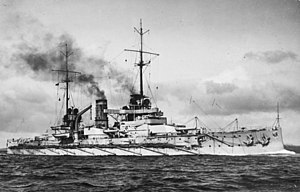
Back Рейнланд (линеен кораб, 1908) Bulgarian SMS Rheinland Czech Rheinland (Schiff, 1910) German SMS Rheinland Spanish اساماس راینلند Persian SMS Rheinland French ריינלנד (אוניית מערכה, 1908) HE SMS Rheinland Italian ラインラント (戦艦) Japanese SMS Rheinland Portuguese
 Rheinland shortly after entering service in 1910
| |
| History | |
|---|---|
| Namesake | Rhineland |
| Builder | Vulcan AG, Stettin |
| Laid down | 1 June 1907 |
| Launched | 26 September 1908 |
| Commissioned | 30 April 1910 |
| Decommissioned | 4 October 1918 |
| Stricken | 5 November 1919 |
| Fate | Ceded to the Allies, later scrapped in 1921 |
| General characteristics | |
| Class and type | Nassau-class battleship |
| Displacement | |
| Length | 146.1 m (479 ft 4 in) |
| Beam | 26.9 m (88 ft 3 in) |
| Draft | 8.9 m (29 ft 2 in) |
| Installed power |
|
| Propulsion |
|
| Speed |
|
| Range | At 12 kn (22 km/h; 14 mph): 8,300 nmi (15,400 km; 9,600 mi) |
| Complement |
|
| Armament |
|
| Armor |
|
SMS Rheinland[a] was one of four Nassau-class battleships, the first dreadnoughts built for the German Imperial Navy (Kaiserliche Marine). Rheinland mounted twelve 28 cm (11 in) main guns in six twin turrets in an unusual hexagonal arrangement. The navy built Rheinland and her sister ships in response to the revolutionary British HMS Dreadnought, which had been launched in 1906. Rheinland was laid down in June 1907, launched the following year in October, and commissioned in April 1910.
Rheinland's extensive service with the High Seas Fleet during World War I included several fleet advances into the North Sea, some in support of raids against the English coast conducted by the German battlecruisers of I Scouting Group. These sorties culminated in the Battle of Jutland on 31 May – 1 June 1916, in which Rheinland was heavily engaged by British destroyers in close-range night fighting.
The ship also saw duty in the Baltic Sea, as part of the support force for the Battle of the Gulf of Riga in 1915. She returned to the Baltic as the core of an expeditionary force to aid the White Finns in the Finnish Civil War in 1918, but ran aground shortly after arriving in the area. Significant portions of her armor and all her main guns had to be removed before she could be refloated. The damage done by the grounding was deemed too severe to justify repairs and Rheinland was decommissioned to be used as a barracks ship for the remainder of the war. In 1919, following the scuttling of the German fleet in Scapa Flow, Rheinland was ceded to the Allies who, in turn, sold the vessel to ship-breakers in the Netherlands. The ship was eventually broken up for scrap metal starting in 1920. Her bell is on display at the Military History Museum of the Bundeswehr in Dresden.
Cite error: There are <ref group=lower-alpha> tags or {{efn}} templates on this page, but the references will not show without a {{reflist|group=lower-alpha}} template or {{notelist}} template (see the help page).
© MMXXIII Rich X Search. We shall prevail. All rights reserved. Rich X Search